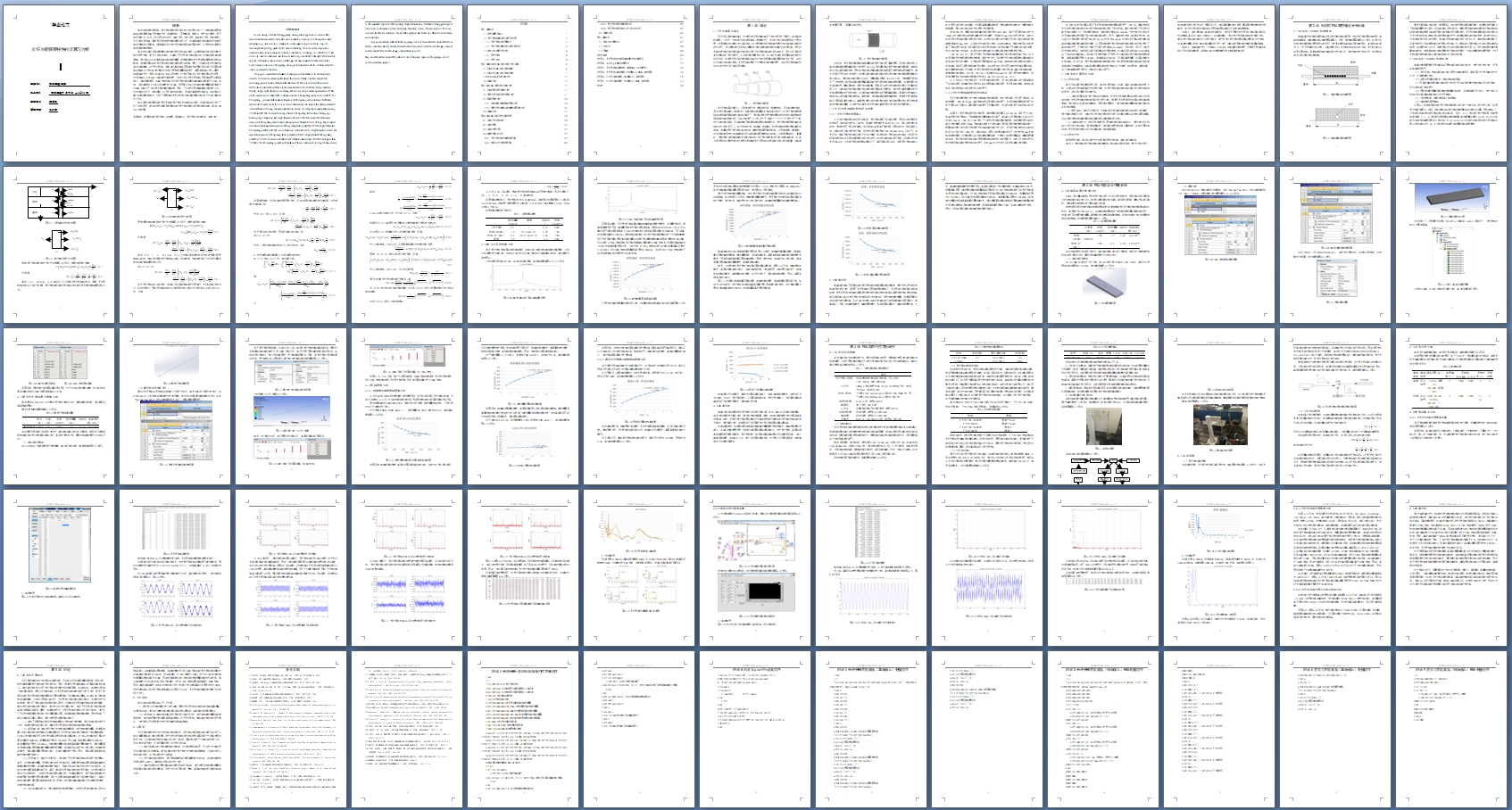光纤光栅频率特性的计算与分析

光纤光栅频率特性的计算与分析(任务书,开题报告,论文21000字)
摘要
如今在传感检测领域,光纤光栅传感技术已成为主流发展方向之一,依据其传感原理制成的传感器有着不受电磁干扰、传输损耗小、灵敏度高、寿命长、便于波分复用、易于组网等优点,并己广泛应用于航空航天、海洋工程、土木工程、石油电力工程、医学检测、生化等众多领域。虽然光纤布拉格光栅传感器应用广泛,但其频率响应指标始终无法满足相关领域的应用要求。而频率响应作为光纤光栅传感系统的固有特性,它受系统自身固有结构等参数的影响。
本文针对实际工程的需要和目前理论研究中存在的问题,以表面粘贴式光纤布拉格光栅为研究对象,基于应变传递理论,计算出了光纤光栅-胶体系统的应变传递率传递函数通解,通过MATLAB仿真系统胶体的杨氏模量、密度等参数对光纤光栅传感器动态特性的影响,得到表面粘贴式光纤布拉格光栅胶体层的优化参数。同时,分别建立光纤光栅和胶体的仿真模型,对于光纤光栅,仿真分析其在胶体不同粘接力和预紧力的作用下对固有频率的影响;对于胶体,通过模态分析在不同杨氏模量和密度下,其固有频率的变化。最后,搭建实验平台,选用353ND和EP1640两种胶,对光纤光栅及应变片传感系统进行研究,对系统输入10-2000Hz的单频及扫频信号,分析应变片及光纤光栅在不同粘接层下的频率响应,实验结果表明,353ND胶体粘接下的光纤光栅在低频段的幅值响应要高于EP1640胶体,而在高频段,EP1640胶体要优于353ND,原因是EP1640胶体的弹性模量和密度高于353ND。粘贴于下方的光纤光栅靠近激振源,因此,下方的光纤光栅幅值响应要高于上方。对比电阻应变片,在低频段,应变片有较好的响应,而其对高频段没有响应。这与理论计算分析结果趋势相近,证明了表面粘贴式光纤光栅-胶体系统模型与粘接工艺的正确性和可行性。
本文通过对表面粘贴式光纤光栅中光纤光栅-胶体系统从理论、仿真和实验上进行了可行性的研究,本文的研究成果为表面粘贴式光纤光栅传感应用提供参考依据,具有广阔的应用前景。
关键词:表面粘贴式光纤光栅;粘接层;频率响应;光纤光栅-胶体系统;仿真分析
Abstract
Now,in sensing fields,fiber Bragg grating sensing technology has become one of the mainstream development directions,the sensors made by its principle of sensing have many advantages, e.g. anti-corrosion, immunity to electromagnetic, high sensitivity, long life, wavelength multiplexing capability for sensor networking. They are widely employed in numerous areas, such as aerospace systems, ocean survey, seismology, civil structures, oil and electricity, medical instrument, and chemical and biological industry. Although FBG has widely applied, its frequency responsecan’t meet the applied requirementsof related areas all the time.Frequency response is fiber grating sensing system character, which is influenced by the intrinsic parameters of system.
This paper is aimed at the demands of actual projects and troubles exist in theoretical research. It is based on strain transfer theory, the object of study is surface mount FBG, calculating general solution of the transfer function of FBG-colloid system.Then we use MATLAB to simulate the influence to dynamic characteristic of FBG by Young's modulus, density, length, width, thickness, calculating adhesive layer’s optimization parameters of FBG. At the same time, we establish the simulation model of fiber grating and colloid in ANSYS. For fiber grating, we simulate the natural frequency of fiber grating in the situation of different adhesive force and preload; for colloid, we use modal analysis to analyze the modal parameters in the difference of Young's modulus and density. Finally, we set up experiment platform, using 353ND and EP1640 to research sensing system of fiber grating and resistance strain gage. Entering single frequency and sweep frequency from 10-2000Hz to analyze the frequency response of fiber grating and resistance strain gage in differentof colloid sticking. Experimental result shows thatamplitude response of fiber grating that is pasted by 353ND is higher than the fiber grating pasted by EP1640 in low-frequency section.However, in high-frequency section, the amplitude response of fiber grating that is pasted by EP1640 is higher than the fiber grating pasted by 353ND. The reason is that the Elastic Modulus and density of EP1640 are higher than 353ND’s. The fiber gratings pasted in the bottom of the pole are near to exciting vibration source, so the amplitude response of fiber grating is higher than the top. Resistance strain gage has good response in low-frequency section, but in high-frequency section, it has no response. These are similar to the theoretical analysis. It proved the rightness and feasibility of theoretical calculation and simulation.
This paper has feasiblestudied the fiber grating–colloid system of surface mount FBG from theory, simulation and experiment. Research results can provide a reference for the application of surface mount FBG,it has broad application future prospects.
Key words:surface mount FBG; adhesive layer; frequency response; fiber grating–colloid system;simulation analysis
[资料来源:www.doc163.com]

目录
第1章绪论 1
1.1 研究背景及意义 1
1.2 光纤光栅频率特性的研究发展 2
1.2.1 光纤光栅的发展概况 2
1.2.2 光纤光栅频率特性的研究现状 3
1.3 本文的主要研究内容 4
1.3.1 研究内容 4
1.3.2 研究方法 4
第2章粘贴式FBG响应理论分析计算 6
2.1 粘贴式FBG响应传递模型 6
2.2 粘贴式FBG响应传递规律 7
2.3 MATLAB系统仿真分析 12
2.4 本章小结 15
第3章 FBG传感设计仿真分析 17
3.1 粘接层有限元数值分析 17
3.2 裸光纤光栅有限元数值分析 21
[资料来源:https://www.doc163.com]
3.3 影响因素分析 24
3.3.1 胶体模态参数影响因素分析 24
3.3.2 裸光纤光栅模态参数影响因素分析 26
3.4 本章小结 27
第4章 FBG动态特性实验研究 28
4.1 实验平台的搭建 28
4.2 实验原理 32
4.3 实验过程记录 33
4.4 数据采集及分析 33
4.4.1 光纤布拉格光栅数据采集 33
4.4.2 电阻应变片数据采集 40
4.4.3 光纤布拉格光栅数据分析 45
4.4.4 光纤布拉格光栅与应变片比较分析 45
4.5 本章小结 46
第5章结论 47
5.1 本文的主要结论 47
5.2 创新点 48
5.3 展望 48
参考文献 49
附录A 光纤光栅-胶体系统幅频特性仿真程序 51
附录B 自定义plotfft函数程序 53 [资料来源:Doc163.com]
附录C 光纤光栅实验数据(单频输入)处理程序 54
附录D 光纤光栅实验数据(扫频输入)RMS处理程序 56
附录E 应变片实验数据(单频输入)处理程序 58
附录F 应变片实验数据(扫频输入)RMS处理程序 59
致谢 60 [资料来源:Doc163.com]
